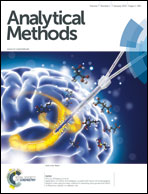Optimization and validation of a multiresidue method for pesticide determination in maize using gas chromatography coupled to tandem mass spectrometry
Abstract
A modified QuEChERS method was optimized for pesticide multiresidue extraction from maize for further GC-MS/MS determination. Extraction was conducted using a simultaneous hydration/extraction process. The clean-up step was performed using low temperature precipitation of lipids followed by dispersive solid-phase extraction (d-SPE). Low temperature precipitation at −18 °C during 12 hours enabled a reduction of co-extractives. Factorial experimental designs allowed the determination of optimum extraction and clean-up conditions. The proposed method was evaluated through the following analytical parameters: linearity, limits of detection (LOD) and quantification (LOQ), accuracy and precision. Results for the instrumental LOD and LOQ were 1.5 and 5.0 μg L−1, respectively, while the practical method LOQ was 40 or 100 μg kg−1 depending on the compounds. Recoveries from spike levels 40, 100 and 200 μg kg−1 were from 70 to 120% with RSD ≤ 20% for most compounds. Evaluation of the matrix effect was performed relating the areas of analytes in pure solvents to areas obtained from organic extracts. The results found were lower than 16.7%, confirming the efficiency of the proposed extraction and clean-up method.


 Please wait while we load your content...
Please wait while we load your content...